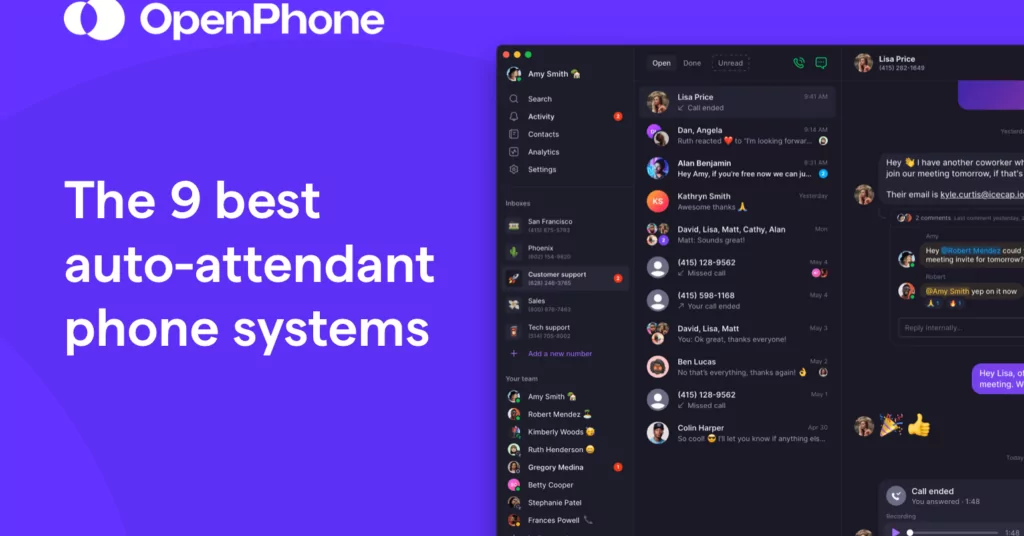Finding the right fit can be harder than it looks. There are thousands of different auto-attendant phone systems on the market, and narrowing down to the best option can take some time.
Thankfully, we’ve done most of the heavy lifting for you. We’ve gathered nine of the best business phone systems with auto-attendant features for 2023.
First, let’s discuss what an auto-attendant actually is and why it’s valuable to businesses in the first place. But if you’re ready to see the top options, you can jump to that section here.
What exactly is an auto-attendant?
Auto-attendants contain recorded greetings and phone menu options that your customers can select from to reach their desired destination. That way, they can automatically be routed to the person or department they’re trying to reach.
Basic auto-attendants provide a script of numbers that callers can press to reach the right person or department (i.e., ‘dial 1 for Sales’). Multi-level auto-attendants let callers use submenus to get even more specific. You can upgrade your auto-attendant even further by writing scripts that respond to both dialed numbers and verbal commands. If you sign up with OpenPhone, you can use interactive voice responses (IVR) that let callers select an extension just by saying the number out loud.

The most obvious benefit of an automated attendant is hands-free routing. You don’t need to delegate any internal resources to streamline your daily call volume — it’s all managed on your behalf! This makes you look even more professional to inbound callers, especially if you’re a smaller team or using a toll-free number.
Auto-attendants are also a great way to enhance the customer experience. Callers don’t have to worry about getting stuck on the call forwarding ‘merry-go-round’ when trying to reach the right person, and your team can offer more personalized customer support based on their skills, department, or caller requests.
There was a time when only call centers and enterprises had access to auto-attendant software. However, with the invention of VoIP numbers, anyone can access and use auto-attendant scripts on their business phone number(s).
Comparing the best phone systems with auto-attendants side by side
Finding the perfect auto-attendant feature starts with finding the perfect phone service.
In a hurry? Here’s a full comparison chart of the nine best phone systems of 2023:
| OpenPhone | RingCentral | Vonage | Nextiva | Ooma | Google Voice | Grasshopper | 8x8 | Phone.com | |
|---|---|---|---|---|---|---|---|---|---|
| Pricing | Starts at $23 per month per user | Starts at $19.99 per user per month | Starts at $19.99 per month per user | Starts at $23.95 per month per user | Starts at $19.95 per month per line | Starts at $10 per month per user | Starts at $26 per month | Starts at $24 per user per month | Starts at $11.99 per user per month |
| Unlimited calling to US & Canada | ✓ | ✓ | ✓ | ✓ | ✓ | Unlimited calls to Canadfrom US only | ✓ | ✓ | Requires upgrade |
| SMS/MMS to US & Canada | ✓ | ✓ | Local US and Canadian numbers only | Requires upgrade | Requires upgrade | US customers only | Local numbers only | x | ✓ |
| Auto-attendant (virtual receptionist) | Requires upgrade | Requires upgrade | Requires upgrade | ✓ | ✓ | Requires upgrade | ✓ | ✓ | ✓ |
| Voicemail transcriptions | ✓ | ✓ | Requires upgrade or add-on | Requires upgrade | Requires upgrade | ✓ | ✓ | ✓ | Requires upgrade |
| Set business hours | ✓ | ✓ | ✓ | ✓ | x | ✓ | ✓ | ✓ | ✓ |
| Additional phone numbers | $5 per number per month | $4.99 per number per month | $14.99 per line per month | x | $9.95 per number per month | x | $10 per number per month | $5 per number per month | $4.99 per number per month |
| Call recording | ✓ | Requires upgrade | Requires upgrade or add-on | Requires upgrade | Requires upgrade | Requires upgrade | x | ✓ | Requires upgrade |
| Shared phone numbers | ✓ | Up to 20 users | x | ✓ | ✓ | Requires upgrade (ring groups only) | $10 per month | ✓ | $5 per month |
| Auto-replies | ✓ | x | x | x | x | x | ✓ | x | x |
| Slack integration | ✓ | Requires upgrade | ✓ | x | x | x | x | ✓ | x |
| Zapier integration | ✓ | Requires upgrade | Requires upgrade | x | x | x | x | x | Requires upgrade |
| CRM integration | Requires upgrade | Requires upgrade | Requires upgrade | Requires upgrade | Requires upgrade | x | x | ✓ | Requires upgrade |
| iOS and Android apps | ✓ | ✓ | ✓ | ✓ | ✓ | ✓ | ✓ | ✓ | ✓ |
| Browser app | ✓ | ✓ | ✓ | x | ✓ | ✓ | x | ✓ | ✓ |
| Desktop apps | ✓ | ✓ | ✓ | ✓ | ✓ | x | ✓ | x | ✓ |
9 best phone systems with auto-attendants
Ready to choose the best auto-attendant phone system for your business? We’ve ranked nine of the most popular options from best to worst based on their prices, features, and integrations.
1. OpenPhone: The best auto-attendant phone system

OpenPhone is the #1 rated business phone platform on G2 — and the best VoIP service for routing inbound calls.
On our Business plan, you can add an auto-attendant with IVR to any phone number. You can have up to ten extensions on a single line (keypad numbers 0 – 9) and can use these to send callers to individual people, teams, or departments. Feel free to send callers straight to any OpenPhone number, route them to external numbers, or ring multiple team members sharing the same number until someone picks up.
You can also use these destination options when you set up an auto-attendant:
- Send calls to a specific member on a shared phone number: Callers can reach individual team members sharing the same phone number
- Playing custom audio files: Add a recording callers hear that contains information based on frequently asked questions such as your business hours or how they can pay any outstanding bills
- Send calls straight to your voicemail box: Once a caller leaves a message, your team can easily review the text voicemail transcription in OpenPhone to prioritize different incoming messages
With OpenPhone, you can port your existing business number and set it up with an auto-attendant just by filling out a two-minute port request form. If you don’t have a number yet or want a few more, you can get as many US, Canadian, or toll-free numbers as your team needs. Each user comes with one phone number. Any additional numbers are just $5 each per month.
OpenPhone’s auto-attendant features are used by thousands of businesses all over the world, but it’s not the only reason our users love us. You’ll also get:
- One local or toll-free number per team member
- Unlimited calls in the US and Canada
- SMS and MMS support for all phone numbers
- Connections with 5,000+ integrations, including Zapier, Slack, and Gmail
- Collaboration tools like internal threads and mentions, call recordings, and contact notes
- AI call summaries and transcripts
Reviews about our platform (and our auto-attendant feature) speak for themselves:
“OpenPhone’s dashboard has a simple-to-use interface. It’s built to enable multiple team members to communicate, follow-up, and reach out to contacts. Auto-replies based on different triggers (e.g. missed call or VM) are unique to OpenPhone and not offered by any other VoIP providers.” — G2
You can try OpenPhone and our auto-attendant feature with a seven-day free trial.
Key Features
- Auto-attendants with interactive voice response options
- 10 keypad menu extensions (0-9)
- Away voicemail greetings
- Auto-replies
- Support for Canadian, US, and toll-free numbers
Pricing

- Starter: $15 per user per month
- Business: $23 per user per month to access auto-attendant, analytics, call transfers, HubSpot integration, and additional phone menu destinations
- Enterprise: A custom price for a custom plan
Check out our international call and text rates on our pricing page.
2. RingCentral

RingCentral is a legacy VoIP platform that caters to large businesses and call centers. All users can access toll-free and local numbers in the US and Canada, as well as:
- Voicemail to text
- SMS support
- Internal team messaging
RingCentral exclusively offers multi-level auto-attendants. You can use these to provide callers with a custom greeting, inform them of your business hours, or provide more detailed submenus if you have lots of internal departments. RingCentral also offers a dial-by-name directory that sends callers to employees based on the first or last name they dial.
Unfortunately, RingCentral doesn’t offer auto-attendants on their basic plan. You’ll need to upgrade to the Standard plan first ($27.99 per user per month), although you still won’t have access to call recordings or third-party integrations unless you pay for the Premium plan ($34.99 per user per month).
Key Features
- Call recording (not automatic until the Premium plan)
- Company business hours
- Assign numbers to receive incoming faxes / SMS
- Dial-by-name directory
- Modify your regional settings according to location
Pricing

- Essentials: $19.99 per user per month
- Standard: $27.99 per user per month to access auto-attendants and on-demand call recordings
- Premium: $34.99 per user per month for CRM integrations and analytics
- Ultimate: $49.99 per user per month to access unlimited storage
3. Vonage

Vonage is a small business phone system that offers voice, video, and text capabilities. Using its mobile and desktop apps, you can access:
- Unlimited calls and SMS in the US (text support is not available in Mexico)
- Unlimited team messaging
- 20 third-party integrations
Multi-level auto-attendants from Vonage are accessible on the Premium tier or higher (starting at $19.99 per line per month). The features are comparable to many other providers: you can route calls to employees, departments, or voicemail, depending on your business hours. You can also prioritize specific phone numbers, which means callers on certain numbers (like your toll-free line) will have routing priority in your daily call flow process.
Keep in mind Vonage’s auto-attendants aren’t available worldwide. Auto-attendants are not available in the UK or Australia.
Key Features
- Send callers to voicemail
- Prioritize certain users’ schedules
- Forward calls to teams or employees
- Set business hours
- Route calls to desk phones
Pricing

Based on teams of four or fewer:
- Mobile: $19.99 per line per month*
- Premium: $29.99 per line per month to access multi-level auto-attendants and CRM phone integrations
- Advanced: $39.99 per line per month to access on-demand call recordings and voicemail transcriptions
* Does not provide the auto-attendant feature
4. Nextiva
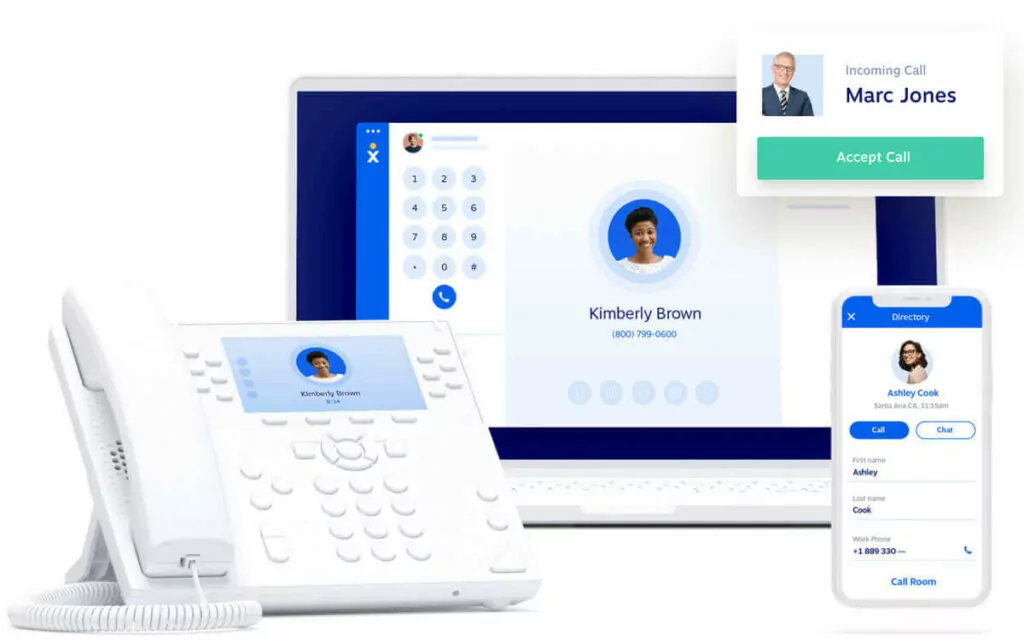
Established in 2006, Nextiva is a legacy VoIP that primarily serves enterprise brands. Their most basic plan comes with some bare-bones features:
- Unlimited internet fax
- Meeting scheduling
- 500 shared contacts
Nextiva offers two types of auto-attendants: a basic auto-attendant on the Essential plan, and a multi-level auto-attendant on the Professional and Enterprise plans. Their multi-level service comes with a prioritized call program, which lets you route calls from toll-free numbers to specific departments faster than other callers.
Keep in mind that none of Nextiva’s auto-attendant systems comes with IVR. While auto-attendants let callers dial a number to reach an extension, they can’t react or respond to verbal commands. If you want IVR or Conversational AI access, you need to pay for the add-on (a one-time fee of $350).
Key Features
- Keypad phone menus
- Keypad submenus
- Custom greetings
- Prioritized calls
- Set business hours
Pricing

For teams of one to four users:
- Essential: $23.95 per user per month
- Professional: $27.95 per user per month for text messaging, CRM integrations, and multi-level auto-attendants
- Enterprise: $3.95 per user per month for call recordings, voicemail transcriptions, and Microsoft Teams integration
5. Ooma
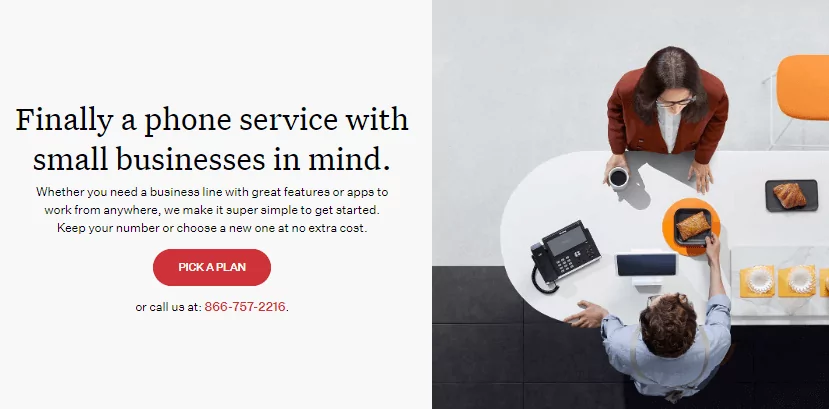
Ooma’s cloud-based phone service is offered to home and business owners alike. The commercial side of their business, Ooma Office, comes with some fairly standard features on the basic plan:
- One toll-free number
- Ring groups
- Audio call transcripts via email
Auto-attendants from Ooma were designed for small businesses and enterprise brands alike. You can route callers to both extensions and ring groups, meaning you can direct incoming calls to one person or ring an entire team until someone picks up the phone. However, Ooma does not offer any collaborative features for your team to work together from a shared inbox.
While you will have access to auto-attendants on the Basic plan, you won’t be able to harness its full potential without upgrading. For example, call recording and enhanced call blocking are only available if you pay extra ($27.99 per user per month). And unless you upgrade to their Call Center plan ($49.99 per user per month), you won’t be able to have an IVR system at all.
Key Features
- Custom messages
- Routing to extensions and ring groups
- Dial-by-name directory
- Business hours
Pricing

- Essentials: $19.95 per user per month
- Pro: $27.99 per user per month
- Call Center: $49.99 per user per month
6. Google Voice for Google Workspace

Most people recognize Google Voice as a cloud-based phone service where you can get a second number for free. However, this isn’t completely true. If you’re looking to use a second number for business use, you’ll have to pay for a full plan — especially if you don’t want to get banned or suspended.
The basic features of Google Voice’s paid business plans include:
- Call forwarding
- Voicemail transcriptions
- 24/7 customer support
Google Voice offers auto-attendants to businesses in the US and 14 select countries. Since it’s multi-level, you can create custom menu options or sub-menus, send callers straight to voicemail, and set holiday closures and business hours.
However, these tools are not available on the free plan, which is for personal use only. Instead, you’ll need to pay for a business phone number and buy a subscription to Google Workspace (an extra $6 per user per month). You’ll also need to upgrade to the Standard plan ($20 per user per month) or Premier plan ($30 per user per month) to access the software. Keep in mind with Google Voice, you’re unable to integrate your auto-attendant phone system with any non-Google apps or set up auto-replies. Text messaging is also only available to US customers.
Key Features
- Virtual phone number
- Auto receptionist
- Call routing
- Set business hours
- Custom welcome messages
Pricing

- Starter: $10 per user per month
- Standard: $20 per user per month for auto-attendants, ring groups, and on-demand call recordings
- Premier: $30 per user per month for automatic call recordings and international locations
For all plans, you need to add an extra $6 per user per month for Google Workspace.
7. Grasshopper

Grasshopper is a virtual phone system that uses your current provider’s network to send and receive calls. In other words, it’s not a true VoIP — it needs to forward calls to your current number, which needs to be supported by a carrier network (think Verizon, T-Mobile, etc).
The basic features on every Grasshopper plan include:
- SMS support
- Voicemail transcriptions
- Concurrent / simultaneous call handling
Although Grasshopper doesn’t directly list an auto-attendant feature, all its plans come with a basic solution. You can record your own custom greeting or pay for a professional to make one on your behalf (a one-time fee of $75). You can also set custom business hours that send callers to voicemail while your business is closed. Grasshopper’s most notable feature is incoming call control, which allows you to screen caller IDs and block spam in advance.
Grasshopper does have some limitations to keep in mind. Users are limited to a specific amount of numbers depending on the plan they select. For example, the Solo plan ($28 per month) only comes with one phone number and three extensions. This means you can only forward callers to one of three possible endpoints. If you don’t want to be limited by a set number of extensions without paying extra, you’ll need to upgrade to the Small Business tier ($80 per month) for five phone numbers and unlimited extensions. Also, if you need multiple people to share responsibility for incoming calls, that is an extra $10 per month with Grasshopper.
Key Features
- Custom greetings
- Call transfers
- Custom business hours
- Incoming call control
- Professional voice recordings for greetings ($75 for up to 250 words)
Pricing

- Solo: $28 per month
- Partner: $46 per month for three phone numbers and six extensions
- Small Business: $80 per month for five phone numbers and unlimited extensions
8. 8×8
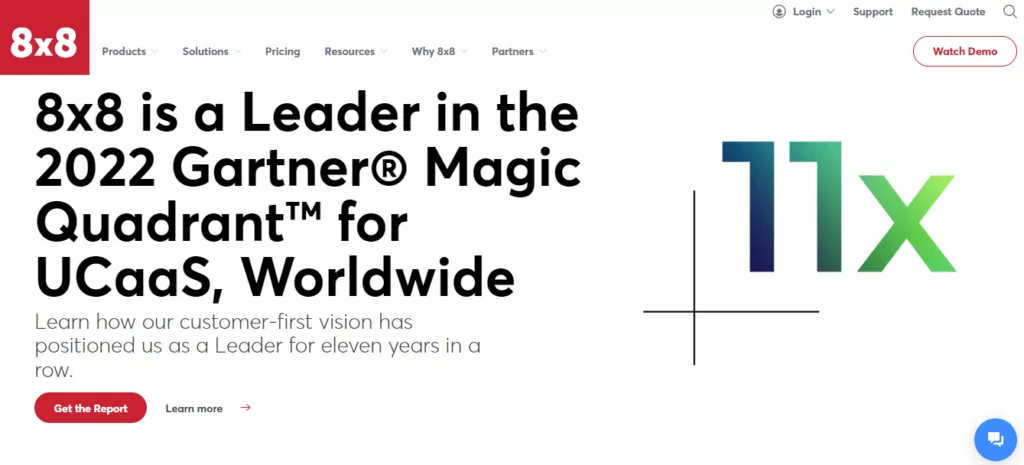
8×8 is a cloud phone service that specifically caters to Enterprise-grade businesses. They do offer unified communications to smaller startups as well, but the included features are somewhat limited (more on this later).
Like RingCentral, 8×8 offers multi-level auto-attendants on its X2 and X4 plans (submenus). However, 8×8 may be limiting as your team grows. Many other key features you get with other business phone systems on their base plans are extra with 8×8, including call recording storage. On their base plan, call recordings are deleted after 90 days.
Their base plan does offer an auto-attendant feature but caps your team in other ways. If you want call forwarding, call queues, or multiple auto-attendants with submenus, you’ll need to upgrade to the highest plan, which costs $44 per user per month.
Key Features
- Keypad phone menus
- Music on hold
- Send to voicemail
- Call forwarding (requires upgrade)
- Call queues (requires upgrade)
Pricing
- X2: $24 per user per month for text messaging, multi-level auto-attendants, and caller ID
- X4: $44 per user per month to access call monitoring and whispering
9. Phone.com

Phone.com supports small to enterprise-level businesses with a virtual business phone system. Rather than charging per plan, Phone.com charges per user, which means your costs will vary according to the permissions you assign. You can mix and match these permission types to suit your business needs.
For example:
- Basic users get 500 pooled minutes, 1,000 pooled text segments, and one phone number per account
- Plus users get unlimited minutes, conversational text messaging, and one phone number per user
- Pro users get call recordings, call analytics, and CRM integrations
Like Grasshopper, Phone.com doesn’t expressly list an auto-attendant feature. However, users can still access phone menus, call queues, and a dial-by-name directory to route calls where they need to go. Users can also access call queuing, which sends customers to a virtual ‘lobby’ that plays hold music while they wait for a rep. Voice tagging, another unique feature, tells teammates what extension a caller selected so they know how to address them when picking up (i.e., ‘thanks for calling the Billing department, how can I help?’).
Team collaboration with auto-attendants is somewhat limited on Phone.com. For example, call recording costs an additional $8 per month on the Basic and Plus plans, which means you’ll pay extra to give your team added context. You’ll also need to pay more if you want a shared number with your team (an extra $5 per month). You’re welcome to opt for a live receptionist if you want, but the price is much higher — $90 per month regardless of your plan.
The most glaring issue with Phone.com is their base plan only includes one phone number per account and has a limited amount of call minutes and text messages you can send per month.
Key Features
- Dial-by-name directory
- Voice tagging
- Phone menus
- Custom greetings
- Call queues
Pricing

- Basic users: $11.99 per user per month (comes with 500 call minutes and 1,000 text segments per month)
- Plus users: $15.99 per user per month for unlimited calling to the US and Canada and voicemail transcriptions
- Pro users: $23.99 per user per month to access call recordings and call analytics
6 key things to look for in an auto-attendant phone system
Are you deciding between two or more phone platforms with auto-attendants? As you narrow down the list of potential service providers, be sure to keep these six critical factors in mind.
1. Transparent pricing
Know in advance how much a phone system will cost before signing on the dotted line — especially the price of its auto-attendant feature if it’s not already included in your plan. When a service is actively hiding its additional costs or fees, you may want to look elsewhere. After all, if a phone system can’t be up-front about its prices, what else might it be hiding?
You can browse OpenPhone’s price plans and add-on costs whenever you please.
2. Call flow customizations
Your business phone solution should route calls exactly the way you want. Customizable menu systems and VoIP call forwarding / transferring tools can help send inbound calls to the right team member at the right time, which will ultimately boost customer satisfaction and keep your team members focused. Plus, round-robin call routing ensures there’s always someone around to pick up.
With OpenPhone, you can access call forwarding, call transfers, and round-robin tools on our Business plan ($23 per user per month). You’ll also have access to set up custom ring order groups so that specific teammates with access to your shared number receive incoming calls first.
3. Streamlined setup
It should be easy to set up an auto-attendant for your business. Before you choose a provider, ask yourself: how easy is it to implement and customize their auto-attendant feature? If not, how easily can you get in touch with customer support for help?
OpenPhone’s auto-attendant feature can be set up in five minutes or less. If you do have other questions or need some extra support, you can reach out to us through the Help Center.
4. Shared numbers
If you’re a growing business, you’ll want to use shared numbers to maximize the value of your auto-attendant. In case the concept of shared numbers is new to you, these are business numbers that can be used by multiple members of the same team.
Shared business numbers ensure that no important calls fall through the cracks. An incoming phone call will ring every person who has access to the shared number and stops ringing once the call has been picked up by a member of the team. This lets your team split responsibility for incoming calls on any device.
With OpenPhone, everyone on your team can make and take phone calls at the same time. Because you’re all on the same number, everyone can easily review the history of a conversation and even tag each other in conversations to work together on responses.
5. Call recordings
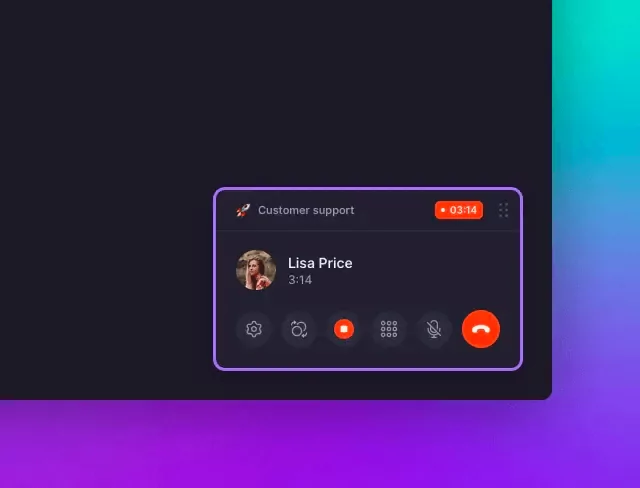
Some callers reach out with questions that need to be kept for future reference. With call recording software, you can forward a recording of your recent call to another member of the team, or if you manage others, provide them additional coaching. Everyone will have the context they need to work on problems and solutions, resulting in happier customers and more effective team members.
With OpenPhone, call recordings are available on all three plans. You’ll even have access to an auto-record feature that doesn’t require you to manually hit record at the beginning of every call.
6. Save time on repetitive tasks
Auto-attendants are a great way to delegate tedious tasks to technology — but it’s not the only kind of automated tech that can save you time.
Advanced communications platforms should be able to accommodate and automate any work that doesn’t have to be done by a human. For example:
- Texting automation options like auto-replies that instantly respond to customers after they leave a voicemail or send a text, even if you’re not around.
- The best auto-attendant phone systems integrate with third-party apps that you already own, meaning all your tools can talk to one another and keep your business running smoothly.
- Platforms like Zapier help you automate workflows by letting you text appointment confirmations, push call recordings to other tools, and take other repetitive tasks off your plate.
OpenPhone is the best auto-attendant phone system of 2023
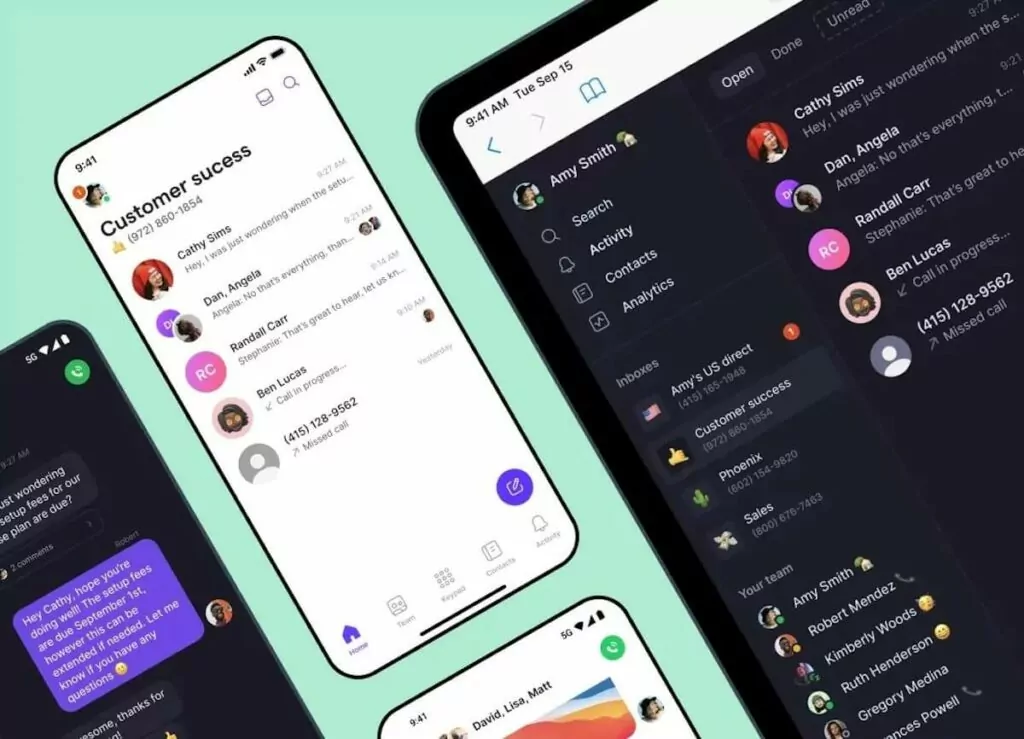
OpenPhone is much more than just an auto-attendant system.
Beyond our phone menus and VoIP call routing features, we help teams build better relationships with their customers through shared phone numbers, streamlined texting options, and thousands of third-party apps that make call management a breeze.
Thousands of global brands chose OpenPhone to help their businesses thrive. Sign up for a seven-day free trial to see why for yourself.
FAQs
Automated answering systems streamline call management, ensure efficient call routing, and improve customer satisfaction by providing quick responses and directing callers to the appropriate department or information.
Yes, modern VoIP solutions allow the integration of auto attendants with cell phones, enabling businesses to manage calls professionally and efficiently even on mobile devices.
An automated telephone system offers prompt, faster customer assistance, reduces wait times by directing callers to the right department, and improves overall customer satisfaction with professional handling.
Look for customizable greetings, multi-level menu options, integration capabilities with your CRM, and scalability to grow with your business needs.
For small businesses, an answering system is essential for managing high call volumes efficiently, providing a professional image, and ensuring no call goes unanswered, which can improve customer trust and retention.
